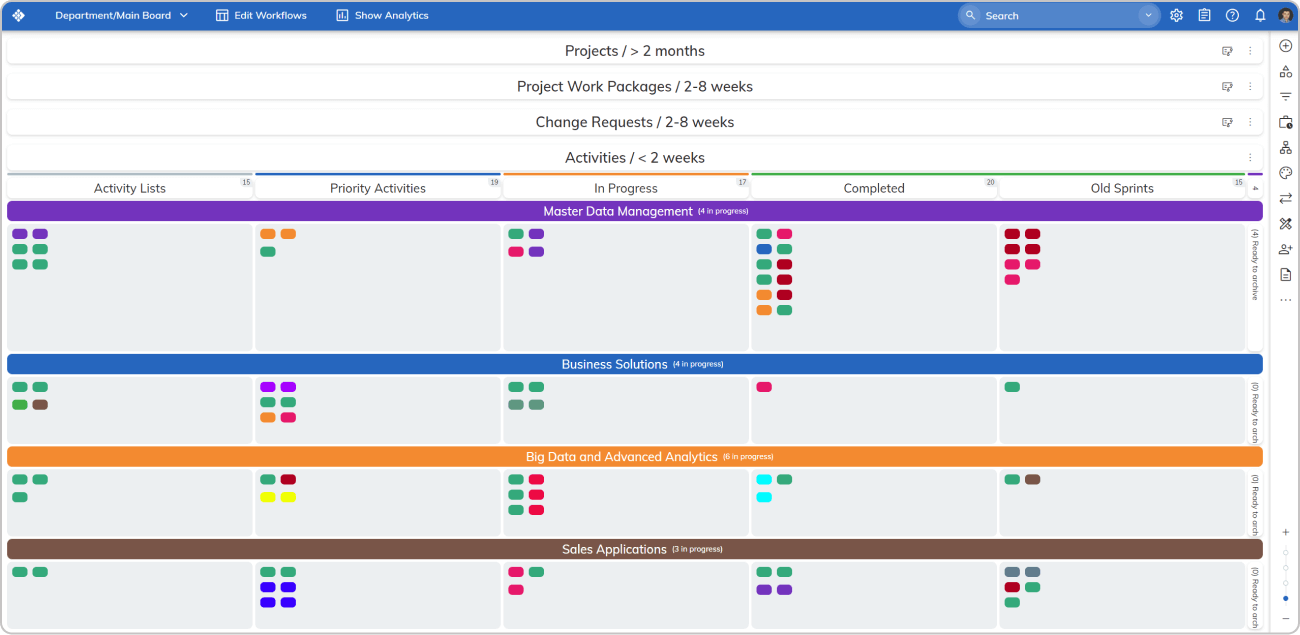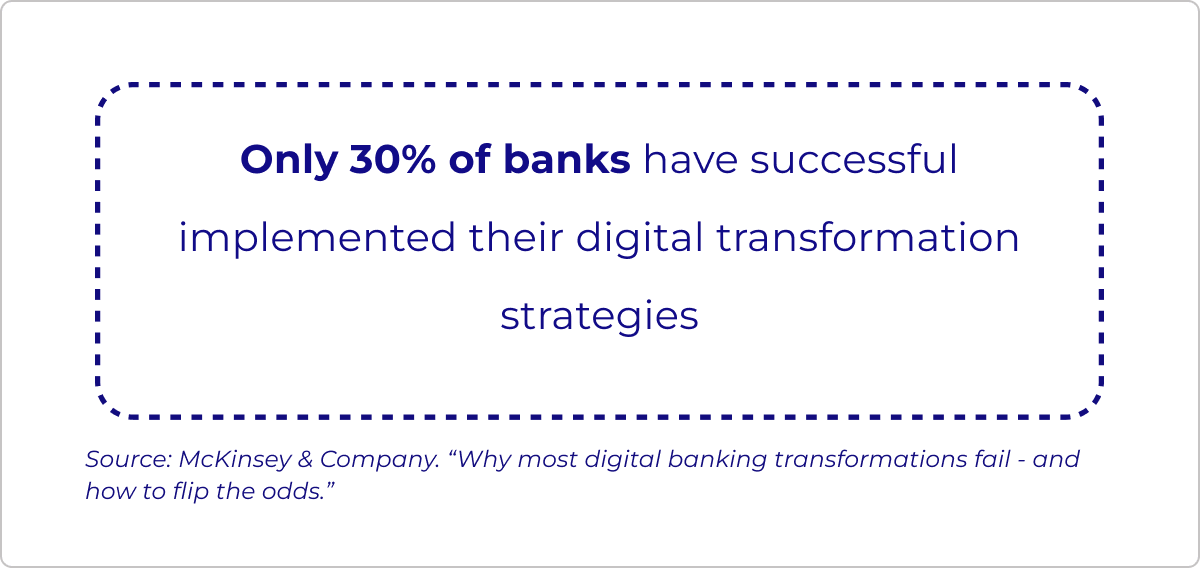Agile and digital transformations often go hand in hand, and we're about to dive into five riveting scenarios from the food, finance, and telecom industries. In each case, we'll explore the ambitious goals driving their transformations, the pressing needs that sparked these changes, the challenges the teams encountered, and the ingenious solutions they implemented. And, of course, we'll top it all off with the cherry on top – their remarkable achievements.
Case Study: Taking a Hybrid Approach to Agile Transformation in the Food Industry
Turkey's largest dairy producer urgently needed to speed up their delivery processes. They embarked on an Agile transformation journey, starting with a pilot team of 40 members. With the help of Agile coaches, they devised a plan that combined iteration and flow-based practices tailored to their specific needs.
AK Gida, like many organizations, aimed to speed up delivery but faced several hurdles:
- Low organizational transparency
- Scattered project activities across systems
- Internal and external dependencies causing delays
To address these issues, multiple workshops were held to explore various ways of working. The team decided to use Kanban practices for categorizing work and managing projects while delivering iteratively in 2-week sprints using Scrum. Regular feedback loops, including daily stand-ups and retrospectives, were incorporated to ensure continuous improvement and team member input.
Building a Clear Work Breakdown Structure: Using value stream mapping, the team created a centralized system to manage all projects, change requests, and activities. They categorized workflows into three types:
- Projects taking more than 2 months
- Smaller projects and change requests take between 2 weeks and 2 months
- Work activities and more minor change requests take less than 2 weeks
 Visualizing workflow activities on a kanban board in Businessmap
Visualizing workflow activities on a kanban board in Businessmap
This structure provided full transparency at all levels (project, feature, activity) and allowed project managers to track the source of work quickly.
Analyzing Dependencies: To identify which dependencies caused the most delays, the team used custom visual signals for each vendor. This data sparked constructive conversations and led to a 21% improvement in block time with third-party suppliers over just 4 months.
By adopting a hybrid approach to work management and focusing on transparency, feedback, and dependency management, AK Gida significantly improved its delivery processes, setting a solid foundation for future growth.
Read more: AK Gida Case Study
Case Study: BBVA's Leap toward Organizational Agility beyond Teams in One Year
Banco Bilbao Vizcaya Argentaria (BBVA) embarked on a mission to enhance organizational agility by synchronizing all teams to deliver products and services predictably and sustainably. A bold but necessary mission. Starting in 2014, BBVA was an early adopter of agile practices. By 2019, 30,000 employees were using agile methods daily. Here's a snapshot of their journey.
The Finance division, the first non-IT area to embrace Agile, faced several challenges:
- Increasing the success rate of finance projects
- Developing flexibility in managing BAU (Business as Usual) services
- Managing dependencies between teams and levels more efficiently
- Shifting focus from resource utilization to service delivery improvement
- Overcoming resistance to data collection on team demand and capability
To address these challenges, BBVA hosted workshops for Program Managers and teams to introduce Kanban practices. These sessions focused on managing workflow, handling blockers, and analyzing lead times and dependencies.
A breakthrough was earning employees' trust in the importance of data collection. This trust was crucial for understanding processes and enhancing service delivery. Monthly data analysis revolutionized work management, cleared bottlenecks, and made forecasting future needs more accurate and straightforward.
Pilot Success
The pilot team's success paved the way for the first end-to-end service involving three cross-functional teams. They improved process understanding and dependency management by visualizing their workflow on a shared kanban board, using clear policies, holding weekly coordination meetings, and analyzing flow data. This approach increased trust and created a resilient service network responsive to customer needs.
After a year, the pilot team achieved remarkable outcomes:
- 28% reduction in management costs (time spent in agile ceremonies)
- 25% reduction in lead time for information requests
- 17% reduction in lead time for incident resolution
BBVA's adoption of Kanban practices, expert coaching, and strong leadership support led to substantial improvements. Their journey highlights the transformative power of Agile in building a responsive and efficient organization.
Read more: BBVA Case Study
Case Study: Algar Telecom's Journey to Boost Digital Readiness with Agile Practices
For over 70 years, Algar Telecom has led the way in the telecom industry. Dedicated to enhancing customer experience and service delivery, the company saw the need to modernize its management practices across all divisions.
To foster a digital mindset, Algar Telecom's Integration department embarked on a digital transformation journey. This department needed to align with the Business division, which was already embracing agility through agile practices. However, the traditional methods of the Integration division created friction, hindering cooperation between the departments.
To name a few of the critical challenges:
- Cultural Clash: The Integration department's traditional work methods conflicted with the Business division's agile practices, making collaboration difficult.
- Lack of Standardization: The Integration team faced unclear delivery metrics and non-standardized workflows.
The agile transformation of the division included three major areas:
- Work Boards: They started by implementing kanban work boards to help the Integration team map out end-to-end delivery steps, offering a centralized view of projects, initiatives, and tasks. This visualization allowed them to identify bottlenecks and improve workflow connectivity.
- Customer Collaboration: Furthermore, by sharing work boards with customers, they facilitated real-time feedback and quick responses, enhancing the digitalization of the work process from conceptualization to delivery.
- Performance Analysis: Additionally, leveraging work performance data provided a comprehensive overview, saving time from manual reporting and enabling the team to understand customer needs better. Centralized tracking of delivery metrics empowered management to make more assertive decisions.
 A summary of work performance data using the Workflow Performance widget in Businessmap
A summary of work performance data using the Workflow Performance widget in Businessmap
Adopting agile practices and utilizing powerful project management tools like Businessmap (previously known as Kanbanize) led to significant improvements. Operational processes became more agile across various organizational levels, and the success of these practices gave management the confidence to experiment with OKRs (Objectives & Key Results), aiming to integrate goal tracking and execution in one place.
Algar Telecom's journey to boost digital readiness through agile practices transformed its operational landscape. By modernizing management practices and fostering a digital mindset, the company improved collaboration, enhanced customer experiences, and positioned itself for future growth and innovation.
Read more: Algar Telecom Case Study
From a Traditional Bank to a Digital Organization: How Agile and Digital Transformations Enable HSBC to Innovate at Scale
While banks face tremendous pressure to digitize, only 30% that have undergone a digital transformation report successfully implementing their digital strategy. The biggest problem – innovating at scale. Indeed, a Business Growth survey led by HSBC UK showed that innovative thinking is the critical factor that drives the growth ambitions of successful entrepreneurs and business leaders.

It's no surprise that HSBC's agile and digital transformations were instrumental in driving innovation at scale. By dismantling silos, focusing on customer-centric metrics, investing in technology, and fostering continuous learning, HSBC is successfully navigating the complexities of digital and agile transformation to enhance its global operations and deliver exceptional customer experiences.
HSBC faced several challenges in the process of transforming into a digital-first organization:
- Scaling Operations: How to effectively scale operations across a global platform.
- Digitization and Automation: How to digitize and automate processes efficiently.
- Data Utilization: Leveraging existing data to drive business decisions and improve customer experiences.
Agile Transformation: HSBC adopted an agile approach to foster a culture of speed and innovation. This shift involved:
- Breaking Down Silos: Moving away from traditional, siloed structures to create autonomous teams focused on rapid delivery.
- Customer-Centric Metrics: To measure transformation success, implement metrics such as Net Promoter Score (NPS), customer engagement scores, and the number of digitally active customers.
- Empowered Teams: Enabling teams to make decisions and deliver value based on customer needs and outcomes.
Digital Transformation: To support its digital ambitions, HSBC aimed to become a customer-focused and value-proposition-led organization. Key initiatives included:
- Investment in Technology: Significant investments were made in next-generation technologies to enhance resource utilization and capabilities for real-time decision-making.
- Cloud Services Expansion: Doubling their cloud-hosted services within 12 months to harness the scalability and innovation potential of cloud computing. This enabled 97% of payments to be processed end-to-end without manual intervention.
- Continuous Learning: Ongoing digital training and coaching at all organizational levels to ensure employees are equipped with the necessary skills and knowledge.
HSBC established standard metrics and goals across the organization to ensure cohesive progress. This unified approach ensured that every team member's work aligned with customer-oriented objectives, fostering a shared understanding and commitment to the transformation goals.
Source: HSBC Wealth and Personal Banking's Agile Transformation Journey
Case Study: Lego's Transformation Journey to a Digital Enterprise
Lego, the beloved toy company, has always seemed ahead of trends. However, by 2016, management felt the need to become a digital company, integrating digitalization across its products and processes. This meant transitioning from a traditional brick-and-mortar business to a digital enterprise that produced digitalized toys and cultivated consumer relationships across various channels.
Some of the critical issues that required attention included:
- Defining Outcomes: Struggling to pinpoint the desired outcome and essential success factors.
- Operational Inefficiencies: Slow, rigid production processes and hectic innovations cause inefficiencies in purchasing, production, planning, and distribution.
- Supply Chain Issues: Lack of transparency and coordination in the supply chain.
To tackle these challenges, LEGO implemented a unified technology platform to standardize processes and enhance data sharing. Regular meetings identified 13 critical processes in the global supply chain, leading to simplified distribution and fewer suppliers. Collaborating closely with suppliers also optimized inventory management and distribution.
In 2011, LEGO launched a new product lifecycle management system, automating processes and boosting product output by 50%. Accurate data collection fostered better decision-making.
Indeed, streamlined decision-making and a global collaborative culture were the key capabilities that convinced management to prioritize digitalization.
Henrik Amsinck, LEGO Group's CIO, emphasized the success of the collaborative culture: "You have to respect the networks and talk to everybody whether they are high or low. You have to onboard everybody and get their feedback, adjust your decision, do timely changes, etc. But then, when you execute, you feel no resistance."
Another testament to this new mindset is LEGO's use of social networks and fan groups. By quickly engaging with customers and gathering product ideas, LEGO was able to shorten the product innovation lifecycle. Embracing experimentation and continuous innovation has been crucial to LEGO Group's transformation. The journey to enhance its people, processes, and platforms continues, driving growth and innovation.
Businessmap is the most flexible software, helping your company gain visibility across all projects/portfolios, align on goals, and deliver quality work faster.

Iva Krasteva
Content Strategist | Agile Practitioner | Kanban Certified
Iva is a Kanban-certified Agile expert with hands-on experience in SEO, content creation, and Lean practices. She has published dozens of articles on Lean, Agile, and Kanban practical applications. Iva actively promotes collaborative, flexible work environments and regularly shares process optimization insights through writing.



